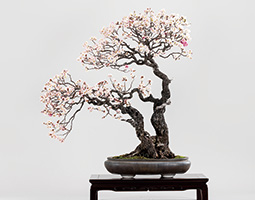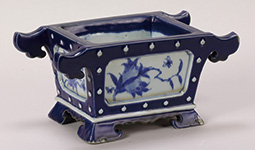INDEX
- English
- 日本語

Udei dark clay unglazed rectangular pot with outer rim (Japanese white pine, named “Seiryu,” estimated 350 years old) - English
- 日本語

Udei dark clay unglazed oval pot with landscape design (19th century, Yixing pottery from Jiangsu Province, China, from the former collection of renowned bonsai master Okuma Shigenobu)

Shidei dark purple clay unglazed oval pot (omoi-no-mama species of plum blossom, estimated 120 years old) 
Rimmed rectangular pot with two embossed lines around the base (Japanese black pine, named shishi-no-mai, estimated 100 years old) (Produced by modern Tokoname potter Nakano Gyouzan) 
Trapezoid sometsuke glazed pot with handles featuring pomegranate design (19th century, Seto)
January 2021
Bonki: Perfect Pots for Bonsai

In recent years, Japan’s bonsai culture has spread around the world, while at the same time bonki, the dedicated pots in which bonsai are planted, have also begun to draw note.

Bonsai, the potted plants cultivated for appreciation of their form, have spread around the world while retaining the Japanese “bonsai” name. The number of bonsai enthusiasts has also increased, and since its start in Japan in 1989, the World Bonsai Convention, regarded as the “world cup” of the bonsai community, has subsequently been held once every four years in the United States, Germany, Puerto Rico, South Korea and China. During this time exports of bonsai plants from Japan to Asia and countries in Europe have also grown.
The aesthetics of bonsai lies in expressing a natural scene in its ideal form within a pot. “Bonsai pots are referred to as ‘bonki’ among enthusiasts,” explains Taguchi Fumiya, curator of the Omiya Bonsai Art Museum, Saitama, located in Saitama City, Saitama Prefecture. “We also have terms such as hachi-awase, which refers to matching the shape and size of a pot to the shape and species of the tree to be planted, and hachi-utsuri, which refers to the harmony in the appearance of the tree and the pot, so choosing the right bonki is very important for bonsai. To put it another way, bonsai are appreciated with the planted tree and its container as an integrated whole.”

There are a wide variety of bonki shapes, including round, rectangular, oval, and hexagonal pots. In order to raise trees to be small, bonki are generally shallow. Surface designs also vary. Some bonki are plain, while others bear auspicious patterns such as imaginary plants and animals. The main types of pottery used in bonki include Tokoname ware and Seto ware from Aichi Prefecture, Banko ware from Mie Prefecture, Shigaraki ware from Shiga Prefecture, Kutani ware from Ishikawa Prefecture, and Arita ware from Saga Prefecture.
During the gardening boom of the late Edo period (1603–1867), gorgeous porcelain flowerpots created using the sometsuke technique of blue and white ceramics primarily from the Seto area spread around Japan, but from the Meiji period (1868–1912) onward, more understated earthenware bonki pots created by Yixing potters in Jiangsu Province, China were increasingly imported, and these designs became the standard for bonki. Today, bonki made from Tokoname ware, whose techniques were developed after learning from Yixing pottery, has gained the deep trust of bonsai artists, and all Tokoname potters are enthusiastically engaged in the production of bonki. Tokoname bonki, like the masterpieces from Yixing, are fired at high temperatures to produce an exquisite, smooth ceramic quality with excellent moisture and air permeability. These qualities combine to create the composed grace and growing conditions that are essential for bonsai.

Over time, Tokoname bonki have taken on various colors, shapes and materials to suit a wide variety of bonsai trees. Some bonki are made from different clays that are blended before firing to harmonize with the patina of trees several hundreds of years old. In recent years, the world of bonsai has been further expanded with the emergence of artists who bake more compact and stylish bonki, catering to the popularity of enjoying small bonsai trees indoors.
The 8th World Bonsai Convention was held in 2017 in Saitama City, welcoming around 45,000 people including overseas visitors over three days. Due to COVID-19, the 9th convention has been pushed back one year and is now scheduled for 2022 in Perth, Western Australia. If you have the chance to see bonsai at such an event, paying attention to the bonki together with the trees will surely double the appeal of the bonsai.


